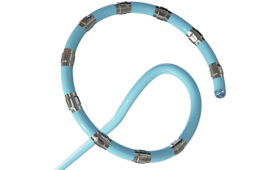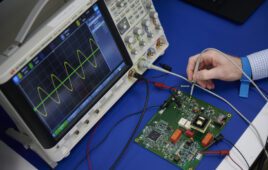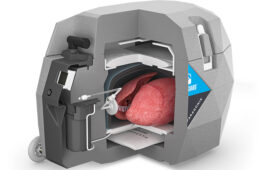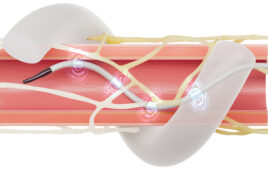 Todd Schwanger, Global Product Manager, Southco Inc.
Todd Schwanger, Global Product Manager, Southco Inc.
The latest development in the digitization of healthcare infrastructure is the accelerating migration from traditional computer monitors to touchscreen devices. The transition is from a static device that simply displays information into one that is continually touched, tapped, and swiped.
Different types of touch screens present new equipment design challenges. To provide the most ergonomic user experience, it’s necessary to balance the force required to hold the display screen in position during use, while still letting users easily move and position the screen to individual preferences.
Design challenges
Good ergonomics is important because touchscreens are the device by which critical patient data is entered and updated – whether by nurses using handheld tablets or mobile data entry stations. Data accuracy is critical, so if the hinge mechanisms mounting and supporting the touchscreens are subject to unneeded or accidental motion when used, the staff can make errors or have to repeatedly correct inputs, reducing their efficiency.
Mobility, one design challenge, impacts how touchscreens are integrated into the current generation of medical equipment. The portability of medical equipment means that machines and terminals must accommodate mobility, while still addressing capability. The mobile nurse station provides an example.
First generation models featured a display screen, keyboard, computer and wireless connectivity, all mounted on wheels to move from room to room for interactions with patients. The latest versions of these mobile systems are rapidly incorporating touchscreens to replace or supplement keyboard interfaces. The screens are often larger than standard desktop computer displays, while some versions are heavier devices that integrate the computer and wireless communications elements into a single, touchscreen-driven system.
The touchscreens, attached to the cart by movable hinges, are usually designed for vertical and horizontal motion. This makes it easier for sharing information with patients, and for collaboration by nursing staff and other patient-care providers. It’s common to see these carts being moved in and out of rooms on any hospital or rehab ward at a shift change.
The increasing use of touchscreens is not limited to the mobile nursing station. For example, ultrasound systems, carts for drug dispensing, and other systems have all become mobile with the goal of reducing the time, effort and risk associated with moving patients from one location to another. In addition, constant usage by many people can create significant demands on the hinge devices holding the touchscreens. The right hinge devices can help ensure long-term touchscreen operation that is efficient, ergonomic, and reliable.
Constant torque holds every position.
The technical capabilities of the latest hinge technology provide industrial design engineers with new options to better integrate and support the use of touchscreens in healthcare applications. Positioning hinges make it possible to define the operating effort required to move or position doors, display screens, safety shields and lights, almost any mounted component that is opened, closed, or moved.
For touchscreens on mobile equipment and in static applications, constant torque hinges are a proven positioning technology with multiple advantages. Constant torque hinges provide smooth operation and infinite positioning of touchscreens. This allows for intuitive movement of the screen that holds it at any point throughout a full range of motion when stopped. The amount of effort required to move it is just enough to respond to deliberate motion, while holding the touchscreen in place for more casual or touch interactions.
Traditionally, this capability is accomplished with clamping or latching mechanisms, which often do not provide the infinite positioning that a constant torque hinge supplies, or the smooth flowing tactile feedback. In addition, a constant torque hinge provides one-handed operation, rather than pushing a button or flipping a lever to move the device.
Multiple users, multiple options.
Constant torque hinges are available in a range of precisely defined holding strengths, so medical-cart designers can select the one that ergonomically works best for how users are expected to interact with the screen. Constant torque hinges provide an intuitive interaction, which is valuable for equipment with multiple users. It’s easy to figure out how to reposition the screen just by applying the right force, rather than figuring out where to flip a lever or push a button.
State-of-the-art constant torque hinges are also engineered for long service life. With multiple daily users constantly moving and adjusting the touchscreens, this is vital. The hinges provide repeatable and consistent motion that lasts much longer than other hinges that use plastic bearings or wave washers for tension.
Constant torque hinges are also useful in another, emerging application: the handheld tablet holder. Healthcare institutions are equipping medical professionals with handheld mobile devices to streamline on-the-job responsibilities. Carrying tablets from location to location lets healthcare professionals improve efficiency of daily tasks.
However, it can be cumbersome to carry tablets around for extended periods, so manufacturers are designing devices with special mounts that let the user effortlessly support the tablet in one hand while entering data with the other. In the same way that constant torque hinging improves positioning of stationary displays, handheld tablet mounts designed with constant torque devices let the user easily adjust the tablet to their own unique preference. When not using the handheld feature of the mount, the same mechanism can be used to affix the tablet to patient’s bed or to stand the tablet on its own – on a table for example – letting the user keep both hands free to perform other tasks.
Although most touchscreens are the size of tablets or desktop monitors, some applications are beginning to use larger, heavier screens, including systems with the computer and wireless communication hardware integrated into the unit. For these heavier devices, combining constant-torque hinges with a counterbalance can provide a more reliable, ergonomic solution. Counterbalance hinges incorporate heavy-duty counterbalance springs that store energy and release it when the screen is repositioned. They provide an excellent solution for applications where the element being lifted has significant weight.
Pre-engineered hinge speeds final design.
Taking advantage of proven, constant-torque technology is a smart way to reduce design risk while saving R&D time and expense. If a design requires that an ultrasound touchscreen tilt with one to two pounds of user effort, the design team has two options: It can spend time on a design that meets the operating specs, or it can simply choose a solution that has this feature designed in.
Pre-engineered, touchscreen positioning technology designed for the demands of the medical environment offers many advantages:
- Their reliability has already been validated by the manufacturer and other companies that have used them.
- The components allow for more streamlined designs, imparting a sleek appearance, eliminating protruding parts and reducing labor costs for installation and assembly.
- Pre-optimized solutions may be specified to match equipment size, operating effort, operating environment and color, further simplifying the design.
- Leading suppliers now offer more compact constant torque hinges engineered to fit more cleanly into thin profile applications
Touchscreen technology is easy and intuitive which is why its use in medical applications will continue to grow. The right hinge and positioning technology can help ensure these devices are efficient and ergonomic, helping healthcare personnel care for patients in the best manner possible.
[Want to stay more on top of MDO content? Subscribe to our weekly e-newsletter.]




